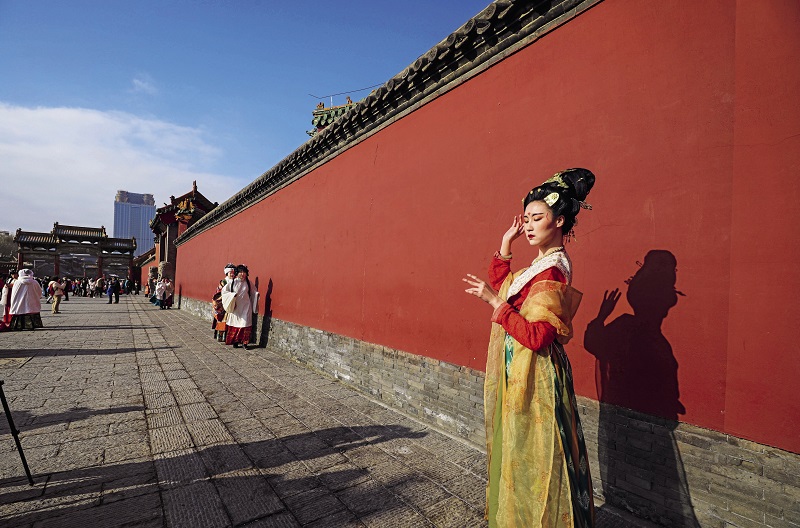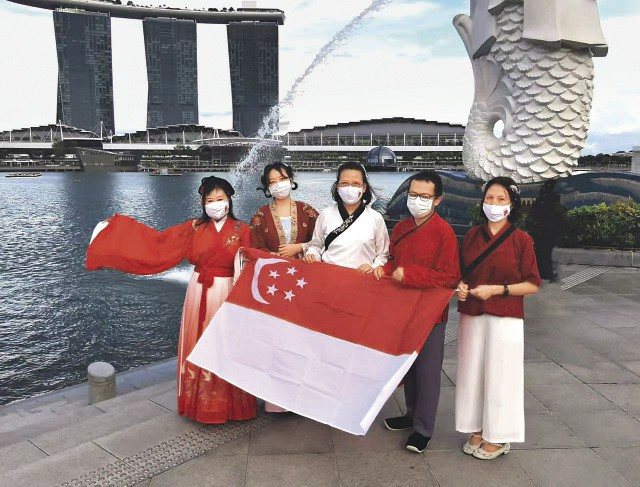Hanfu, or Han-style clothing, evolved from the dress Han Chinese wore in ancient times, and is an iconic symbol of Chinese culture.
In recent years, this traditional Chinese clothing has become better known and loved internationally. In Singapore, for example, fans wear it for various cultural events. Tong Weiqiang, a Chinese living in Singapore, is an avid fan of the clothing. He was first attracted to Hanfu when he was a child. “I was deeply impressed by the costume in martial arts dramas produced by Hong Kong TVB Channel, and began to take a liking to traditional Chinese clothing,” he said.
Now years later, Tong established a cultural club for Hanfu lovers. “For Singaporeans who are interested in Chinese culture and appreciate the beauty of Hanfu, the club is a venue for them to learn more about China’s cultural heritage,” he said.
Lin Xiaoying, vice chairperson of a Hanfu association in Singapore, is dedicated to introducing traditional Chinese culture to overseas Chinese and people of other countries. “Unknowingly, I have taken Hanfu to heart. I have been traveling around the world and organized many promotional events to display to the world the elegance of traditional Chinese clothing. Since a young age, I have been drawn to beautiful things, such as painting and fashion. In adulthood, I traveled extensively in my job, and noticed people in Japan and the Republic of Korea wearing traditional robes. The sight inspired me to share with them the traditional costume of China,” said Lin. “It would be pitiful for me not to wear Hanfu with full confidence,” she added.
“I wore Hanfu for the first time in 2012, and have since fallen in love with it,” said Wu Zengxin, a Taijiquan (or tai chi), coach in Singapore. He has since chosen this dress for all performances he gives, though it is more expensive than a generic martial arts uniform. Gradually, his audience has come to realize the beauty of Hanfu.
“I am sure that I am the first in Singapore to perform Taijiquan in Hanfu. Following my example, more Taiji masters began to perform in the clothing. This is the power of cultural heritage,” said Wu.

At a Hanfu festival held on November 27, 2021, participants dressed up in Hanfu apparel take pictures in front of the entrance to the Shenyang Imperial Palace.
A Long Lineage
The evolution of Hanfu is a reflection of the history of Chinese culture. “Hanfu dates far back into history. Generally speaking, it refers to all the clothing of Han Chinese from the pre-Qin period (before 221 B.C.) to the Qing Dynasty (1644-1911). During the Spring and Autumn and Warring States periods (770-221 B.C.), the Han dress took on elements of those of nomadic ethnic groups, making it more suitable for equestrian activities and archery,” said Cai Danjun, associate professor of the School of Liberal Arts, Renmin University of China.
Though traditional Chinese clothing was predominantly influenced by Confucian culture, it incorporated elements of other cultures and a variety of ethnic groups, she added.
There are many anecdotes in Chinese history involving clothing, said Cai, giving three examples. In late Eastern Han Dynasty, warlord Cao Cao became the de facto ruler of the country. The resentful emperor, Xiandi (181-234), wrote an edict with his blood, and hid it in a waistband to be sneaked out to his ministers, instructing them to assassinate Cao. Many ancient books mention that the Yellow Emperor, one of the legendary Chinese sovereigns and culture heroes, invented early Chinese clothing that consisted of the upper and lower pieces – tunic and unisex skirt – representing the heaven and earth, respectively. And the Book of Changes, dating back to prehistory, said that, “Yellow is the auspicious color for unisex skirts.”
“This shows that the ritual, cultural and aesthetic standards of Chinese attire had taken shape in the pre-Qin period, and evolved in the following centuries as a result of the integration of different ethnic groups and cultures. When we delve into the history and culture behind Hanfu, we can help people in other parts of the world better understand the profound cultural meanings of this clothing,” said Cai.
Wu Zengxin has met people from all over the world in Singapore, and many people from Western countries showed interest in and affection toward the Hanfu he wore. Being of Chinese decent, Tong Weiqiang feels the desire to share stories of Chinese culture with more people. “Hanfu conveys a profound history. Together with other Hanfu fans, I have also organized regular cultural activities in local libraries, sharing with fellow Singaporeans works of Chinese literature, poetry and classical style of writing,” he said.

A group of people wearing Hanfu in the colors of Singapore’s national flag pose for a picture in front of the Merlion, the official mascot of the country, on August 15, 2021.
Modern-Day Appeal
Many Chinese Singaporeans and Chinese living in the country want to learn more about the culture of their ancestral land. “Singapore is a developed country, but society is based on a ‘grassroots culture.’ Earlier generations of Chinese migrated here looking to make a living. Later generations have also embraced a pragmatic way of thinking. Therefore, much needs to be done to enhance their sense of mission to carry on their traditional culture,” said Tong.
Wu is delighted to see more young Singaporeans wearing Hanfu at scenic resorts. He believes that the attire, with its rich cultural significance, is not only a token of China’s sartorial elegance, but also a lens to peep into Chinese culture.
In Lin’s view, Hanfu encapsulates the 5,000-year-old Chinese civilization and gives expression to the Chinese spirit. She finds meaningfulness and pride in carrying on this cultural heritage.
To better promote Hanfu among overseas Chinese, Cai suggested establishing a Hanfu culture system that bridges the past with the present, covers both public activities and academic studies, and puts equal emphasis on sartorial patterns and traditional aesthetic theories.
“Hanfu has deep cultural roots,” said Cai. The Doctrine of the Mean says, “When wearing a fine dress of splendid colors, one should cover it with a linen overcoat.” She explained that this is because ancient Chinese valued modesty and reserve. “How to dig into such ideas imbedded in classical attire to better combine traditional culture with modern life is an area that deserves more attention and effort of modern Chinese people,” Cai added.
YANG NING is a journalist and CHEN JIEMING an intern with the overseas edition of People's Daily.